Slider Sheet Detection in Charge-Induction Electrostatic Film Actuators
Abstract
1. Introduction
2. Charge-Induction Electrostatic Actuator
3. Slider Detection Using Stator Induction Current
3.1. Basic Concept
3.2. Analytical Model
3.3. Procedure of the Analysis
4. Analytical Results
4.1. Behavior of the Proposed Model
4.2. Modified Model
5. Resistance Switching for Robust Detection
5.1. Relationship between the Resistance of Sensing Circuit and Output Signal
5.2. Resistance Switching
6. Experiment
6.1. Experimental Setup
6.2. Measurement without Resistance Switch
6.3. Resistance Switching
6.4. Accuracy for Slider Proximity Detection
6.5. Discussions
7. Conclusions
Author Contributions
Funding
Institutional Review Board Statement
Informed Consent Statement
Data Availability Statement
Conflicts of Interest
References
- Hosobata, T.; Yamamoto, A.; Higuchi, T. Transparent synchronous electrostatic actuator for long-stroke planar motion. IEEE/ASME Trans. Mechatron. 2014, 20, 1765–1776. [Google Scholar] [CrossRef]
- Iguchi, R.; Hosobata, T.; Yamamoto, A. Transparent electrostatic actuator with mesh-structured electrodes for driving tangible icon in tabletop interface. In Proceedings of the Seventh International Conference on Advances in Computer-Human Interactions, Barcelona, Spain, 23–27 March 2014; pp. 288–293. [Google Scholar]
- Nakamura, T.; Yamamoto, A. A multi-user surface visuo-haptic display using electrostatic friction modulation and capacitive-type position sensing. IEEE Trans. Haptics 2016, 9, 311–322. [Google Scholar] [CrossRef] [PubMed]
- Ishizuka, H.; Suzuki, K.; Terao, K.; Takao, H.; Shimokawa, F. Development of high resolution electrostatic tactile display. In Proceedings of the 2017 International Conference on Electronics Packaging (ICEP), Yamagata, Japan, 19–22 April 2017; pp. 484–486. [Google Scholar]
- Jiao, J.; Zhang, Y.; Wang, D.; Visell, Y.; Cao, D.; Guo, X.; Sun, X. Data-driven rendering of fabric textures on electrostatic tactile displays. In Proceedings of the 2018 IEEE Haptics Symposium (HAPTICS), San Francisco, CA, USA, 25–28 March 2018; pp. 169–174. [Google Scholar]
- Yamamoto, A.; Nakashima, T.; Higuchi, T. Wall Climbing Mechanisms Using Electrostatic Attraction Generated by Flexible Electrodes. In Proceedings of the 2007 International Symposium on Micro-NanoMechatronics and Human Science, Nagoya, Japan, 11–14 November 2007; pp. 389–394. [Google Scholar] [CrossRef]
- Prahlad, H.; Pelrine, R.; Stanford, S.; Marlow, J.; Kornbluh, R. Electroadhesive robots—Wall climbing robots enabled by a novel, robust, and electrically controllable adhesion technology. In Proceedings of the 2008 IEEE International Conference on Robotics and Automation, Pasadena, CA, USA, 19–23 May 2008; pp. 3028–3033. [Google Scholar] [CrossRef]
- Wang, H.; Yamamoto, A.; Higuchi, T. A Crawler Climbing Robot Integrating Electroadhesion and Electrostatic Actuation. Int. J. Adv. Robot. Syst. 2014, 11, 1–11. [Google Scholar] [CrossRef]
- Guo, J.; Tailor, M.; Bamber, T.; Chamberlain, M.; Justham, L.; Jackson, M. Investigation of relationship between interfacial electroadhesive force and surface texture. J. Phys. D Appl. Phys. 2015, 49, 1–9. [Google Scholar] [CrossRef]
- Niino, T.; Egawa, S.; Kimura, H.; Higuchi, T. Electrostatic artificial muscle: Compact, high-power linear actuators with multiple-layer structures. In Proceedings of the IEEE Micro Electro Mechanical Systems An Investigation of Micro Structures, Sensors, Actuators, Machines and Robotic Systems, Oiso, Japan, 25–28 January 1994; pp. 130–135. [Google Scholar]
- Ito, M.; Saneyoshi, K. An attempt to make a large-scale stacked-type electrostatic actuator for artificial muscles of robots. In Proceedings of the 2012 IEEE International Conference on Robotics and Biomimetics (ROBIO), Guangzhou, China, 11–14 December 2012; pp. 1182–1187. [Google Scholar]
- Kellaris, N.; Gopaluni Venkata, V.; Smith, G.M.; Mitchell, S.K.; Keplinger, C. Peano-HASEL actuators: Muscle-mimetic, electrohydraulic transducers that linearly contract on activation. Sci. Robot. 2018, 3, eaar3276. [Google Scholar] [CrossRef]
- Jin, C.; Zhang, J.; Xu, Z.; Trase, I.; Huang, S.; Dong, L.; Liu, Z.; Usherwood, S.E.; Zhang, J.X.; Chen, Z. Tunable, flexible, and resilient robots driven by an electrostatic actuator. Adv. Intell. Syst. 2020, 2, 1900162. [Google Scholar] [CrossRef]
- Zhang, G.; Osada, M.; Yoshimoto, S.; Yamamoto, A. A High Performance Muscle-like Actuator using Multi-layer Electrostatic Film Motors. In Proceedings of the 2022 IEEE 31st International Symposium on Industrial Electronics (ISIE), Anchorage, AL, USA, 1–3 June 2022; pp. 1006–1011. [Google Scholar]
- Mukundan, V.; Pruitt, B.L. MEMS electrostatic actuation in conducting biological media. J. Microelectromech. Syst. 2009, 18, 405–413. [Google Scholar] [CrossRef]
- Chu, C.H.; Shih, W.P.; Chung, S.Y.; Tsai, H.C.; Shing, T.K.; Chang, P.Z. A low actuation voltage electrostatic actuator for RF MEMS switch applications. J. Micromech. Microeng. 2007, 17, 1649. [Google Scholar] [CrossRef]
- Allameh, M.; Shafai, C. Tri-electrode MEMS electrostatic actuator with lower control voltage and higher stroke for actuator array implementations. J. Electrost. 2021, 114, 103635. [Google Scholar] [CrossRef]
- Egawa, S.; Higuchi, T. Multi-Layered Electrostatic Film Actuator. In Proceedings of the on Micro Electro Mechanical Systems, An Investigation of Micro Structures, Sensors, Actuators, Machines and Robots, Napa Valley, CA, USA, 11–14 February 1990; pp. 166–171. [Google Scholar]
- Yamashita, N.; Zhang, Z.G.; Yamamoto, A.; Gondo, M.; Higuchi, T. Voltage-Induction Type Electrostatic Film Motor Driven by Two-to Four-Phase Ac Voltage and Electrostatic Induction. Sens. Actuators A Phys. 2007, 140, 239–250. [Google Scholar] [CrossRef]
- Hosobata, T.; Yamamoto, A.; Higuchi, T. An Electrostatic Induction Motor Utilizing Electrical Resonance for Torque Enhancement. Sens. Actuators A Phys. 2012, 173, 180–189. [Google Scholar] [CrossRef]
- Carneiro, F.; Zhang, G.; Osada, M.; Yoshimoto, S.; Yamamoto, A. An Extended Model for Ripple Analysis of 2–4 Phase Resonant Electrostatic Induction Motors. Actuators 2021, 10, 291. [Google Scholar] [CrossRef]
- Hattori, M.; Asano, K.; Higashiyama, Y. The fundamental characteristics of a cylindrical corona motor with multi-blade electrodes. J. Electrost. 1992, 27, 223–235. [Google Scholar] [CrossRef]
- Leng, J.; Liu, Z.; Zhang, X.; Huang, D.; Qi, M.; Yan, X. Design and analysis of a corona motor with a novel multi-stage structure. J. Electrost. 2021, 109, 103538. [Google Scholar] [CrossRef]
- Secker, P.; Scialom, I. A Simple Liquid-Immersed Dielectric Motor. J. Appl. Phys. 1968, 39, 2957–2961. [Google Scholar] [CrossRef]
- Tada, Y. Improvement of conventional electret motors. IEEE Trans. Electr. Insul. 1993, 28, 402–410. [Google Scholar] [CrossRef]
- Kudo, K.; Nishijima, T. No-load characteristics of electret motor with brushes. In Proceedings of the 1988 Fifth International Conference on Dielectric Materials, Measurements and Applications, Canterbury, UK, 27–30 June 1988; pp. 113–116. [Google Scholar]
- Niino, T.; Egawa, S.; Higuchi, T. An Electrostatic Paper Feeder. J. Jpn. Soc. Precis. Eng. 1994, 60, 1761–1765. [Google Scholar] [CrossRef]
- Yamamoto, A.; Yoshioka, H.; Higuchi, T. A 2-DOF electrostatic sheet conveyer using wire mesh for desktop automation. In Proceedings of the 2006 IEEE International Conference on Robotics and Automation, Orlando, FL, USA, 15–19 May 2006; pp. 2208–2213. [Google Scholar]
- Yamamoto, A. Integrated Presentation of Physical Motions and Visual Information Utilizing Electrostatic Force. J. Jpn. Soc. Appl. Electromagn. Mech. 2019, 27, 407–411. [Google Scholar] [CrossRef]
- Egawa, S.; Niino, T.; Higuchi, T. Film Actuators: Planar, Electrostatic Surface-Drive Actuators. In Proceedings of the IEEE Micro Electro Mechanical Systems, Nara, Japan, 30 January–2 February 1991; pp. 9–14. [Google Scholar]
- Amano, K.; Yamamoto, A. Tangible interactions on a flat panel display using actuated paper sheets. In Proceedings of the 2012 ACM International Conference on Interactive Tabletops and Surfaces, Cambridge, MA, USA, 11–14 November 2012; pp. 351–354. [Google Scholar]
- Hosobata, T.; Yamamoto, A.; Higuchi, T. 2-DOF synchronous electrostatic actuator with transparent electrodes arranged in checkerboard patterns. In Proceedings of the 2013 IEEE/RSJ International Conference on Intelligent Robots and Systems, Tokyo, Japan, 3–7 November 2013; pp. 4919–4924. [Google Scholar] [CrossRef]
- Amano, K.; Yamamoto, A. An interaction on a flat panel display using a planar 1-dof electrostatic actuator. In Proceedings of the Proceedings of the ACM International Conference on Interactive Tabletops and Surfaces, Kobe, Japan, 13–16 November 2011; pp. 258–259. [Google Scholar]
- Yamashita, N.; Amano, K.; Yamamoto, A. Interaction with Real Objects and Visual Images on a Flat Panel Display using Three-DOF Transparent Electrostatic Induction Actuators. In Proceedings of the Seventh International Conference on Advances in Computer-Human Interactions, Barcelona, Spain, 23–27 March 2014; pp. 294–299. [Google Scholar]
- Tursini, M.; Petrella, R.; Parasiliti, F. Initial Rotor Position Estimation Method for PM Motors. IEEE Trans. Ind. Appl. 2003, 39, 1630–1640. [Google Scholar] [CrossRef]
- Wu, S.; Reigosa, D.D.; Shibukawa, Y.; Leetmaa, M.A.; Lorenz, R.D.; Li, Y. Interior Permanent-Magnet Synchronous Motor Design for Improving Self-Sensing Performance at Very Low Speed. IEEE Trans. Ind. Appl. 2009, 45, 1939–1946. [Google Scholar]
- Nakashima, S.; Inagaki, Y.; Miki, I. Sensorless Initial Rotor Position Estimation of Surface Permanent-Magnet Synchronous Motor. IEEE Trans. Ind. Appl. 2000, 36, 1598–1603. [Google Scholar]
- Cheung, P.; Horowitz, R.; Rowe, R. Design, fabrication, position sensing, and control of an electrostatically-driven polysilicon microactuator. IEEE Trans. Magn. 1996, 32, 122–128. [Google Scholar] [CrossRef]
- Fernández, D.; Madrenas, J.; Domínguez, M.; Pons, J.; Ricart, J. Pulse drive and capacitance measurement circuit for MEMS electrostatic actuators. Analog Integr. Circuits Signal Process. 2008, 57, 225–232. [Google Scholar] [CrossRef]
- Fukushige, T.; Hayashi, T.; Hata, S.; Shimokohbe, A. Built-in Capacitive Displacement Sensor with Long Full-Scale Range for Electrostatic Microactuators. IEEJ Trans. Sens. Micromach. 2006, 126, 522–527. [Google Scholar] [CrossRef]
- Moore, S.I.; Moheimani, S.O.R. Simultaneous Actuation and Sensing for Electrostatic Drives in MEMS using Frequency Modulated Capacitive Sensing. IFAC Proc. Vol. 2014, 47, 6545–6549. [Google Scholar] [CrossRef]
- Schroedter, R.; Yoo, H.W.; Brunner, D.; Schitter, G. Charge-Based Capacitive Self-Sensing With Continuous State Observation for Resonant Electrostatic MEMS Mirrors. J. Microelectromech. Syst. 2021, 30, 897–906. [Google Scholar] [CrossRef]
- Nishijima, T.; Yamamoto, A.; Yasui, H.; Higuchi, T. A built-in displacement sensor for an electrostatic film motor. Meas. Sci. Technol. 2006, 17, 2676. [Google Scholar] [CrossRef]
- Yamamoto, A.; Suzuki, J. Position Estimation in Singly-Fed Electrostatic Actuation Systems by Superposing Sensing Signals. Appl. Mech. Mater. 2014, 541–542, 1487–1491. [Google Scholar] [CrossRef]
- Bluett, S.; Helps, T.; Taghavi, M.; Rossiter, J. Self-Sensing Electro-Ribbon Actuators. IEEE Robot. Autom. Lett. 2020, 5, 3931–3936. [Google Scholar] [CrossRef]
- Zhang, G.; Yamamoto, A. Sensorless Displacement Estimation for an Electrostatic Film Motor Using Driving Currents. Int. J. Appl. Electromagn. Mech. 2019, 60, 247–261. [Google Scholar] [CrossRef]
- Zhang, G.; Yamamoto, A. Position estimation of synchronous electrostatic film motors under pulse-voltage operation by using driving currents. Sens. Actuators A Phys. 2021, 332, 113154. [Google Scholar] [CrossRef]
- Ly, K.; Kellaris, N.; McMorris, D.; Johnson, B.K.; Acome, E.; Sundaram, V.; Naris, M.; Humbert, J.S.; Rentschler, M.E.; Keplinger, C.; et al. Miniaturized Circuitry for Capacitive Self-Sensing and Closed-Loop Control of Soft Electrostatic Transducers. Soft Robot. 2021, 8, 673–686. [Google Scholar] [CrossRef] [PubMed]
- Yamamoto, A.; Niino, T.; Higuchi, T. Modeling and Identification of an Electrostatic Motor. Precis. Eng. 2006, 30, 104–113. [Google Scholar] [CrossRef]
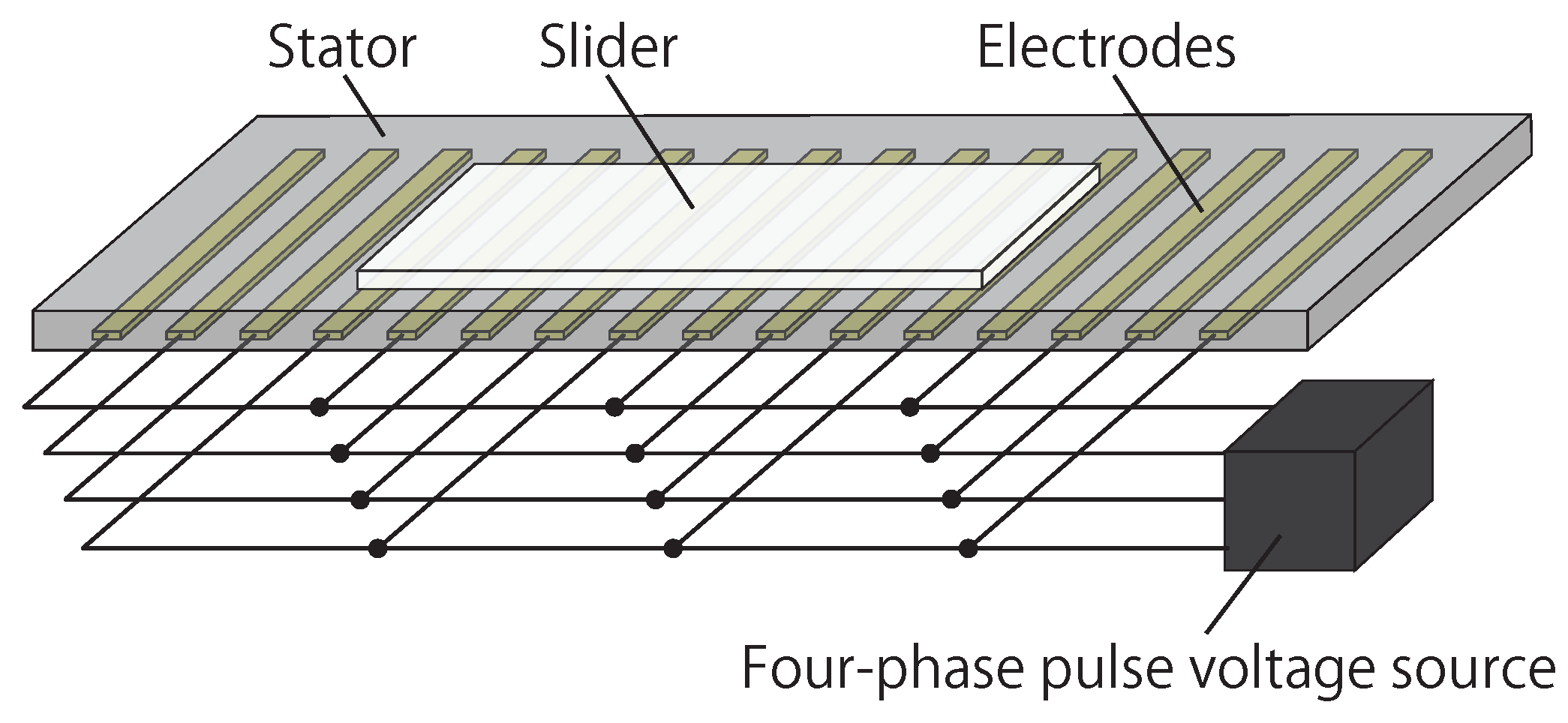

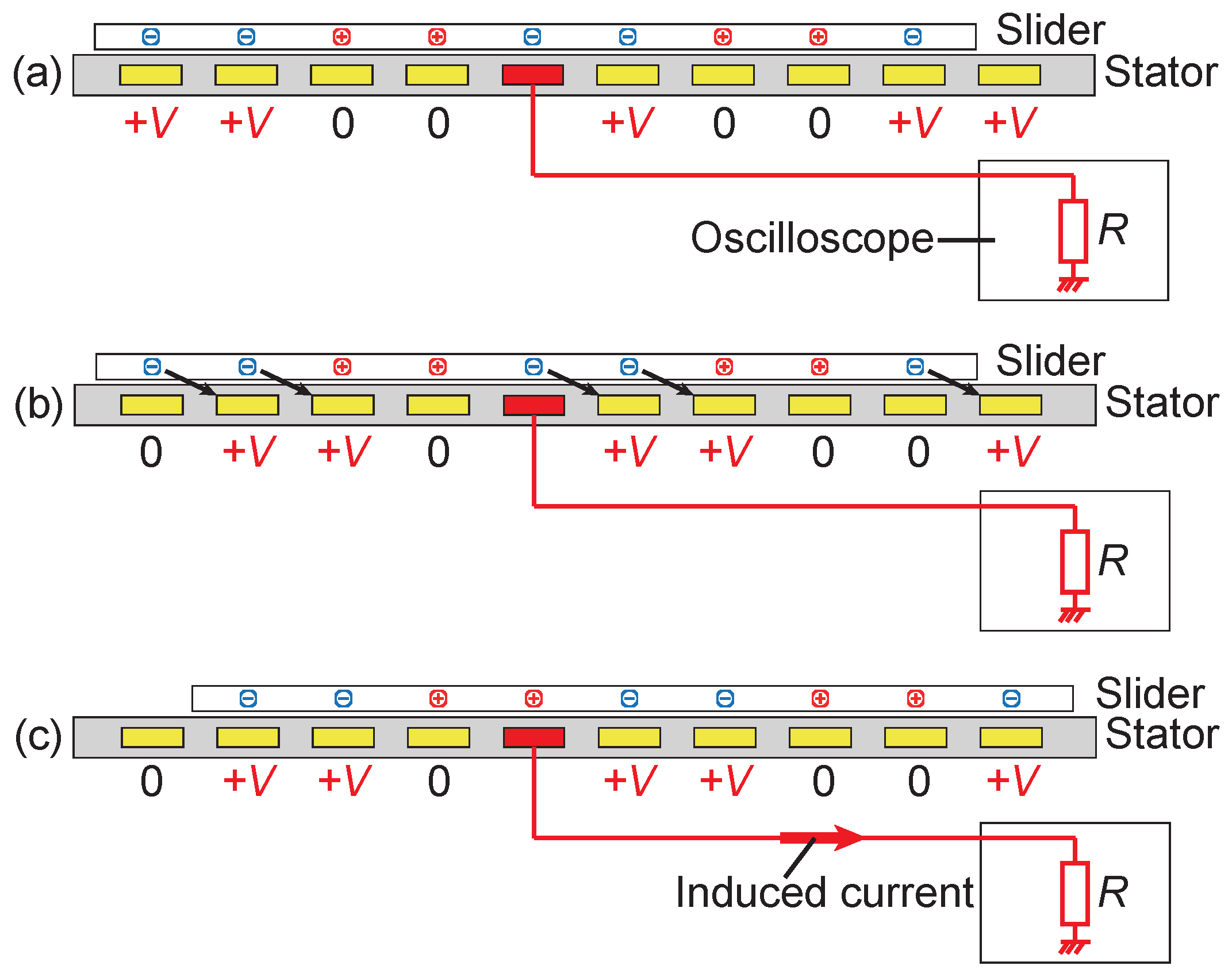
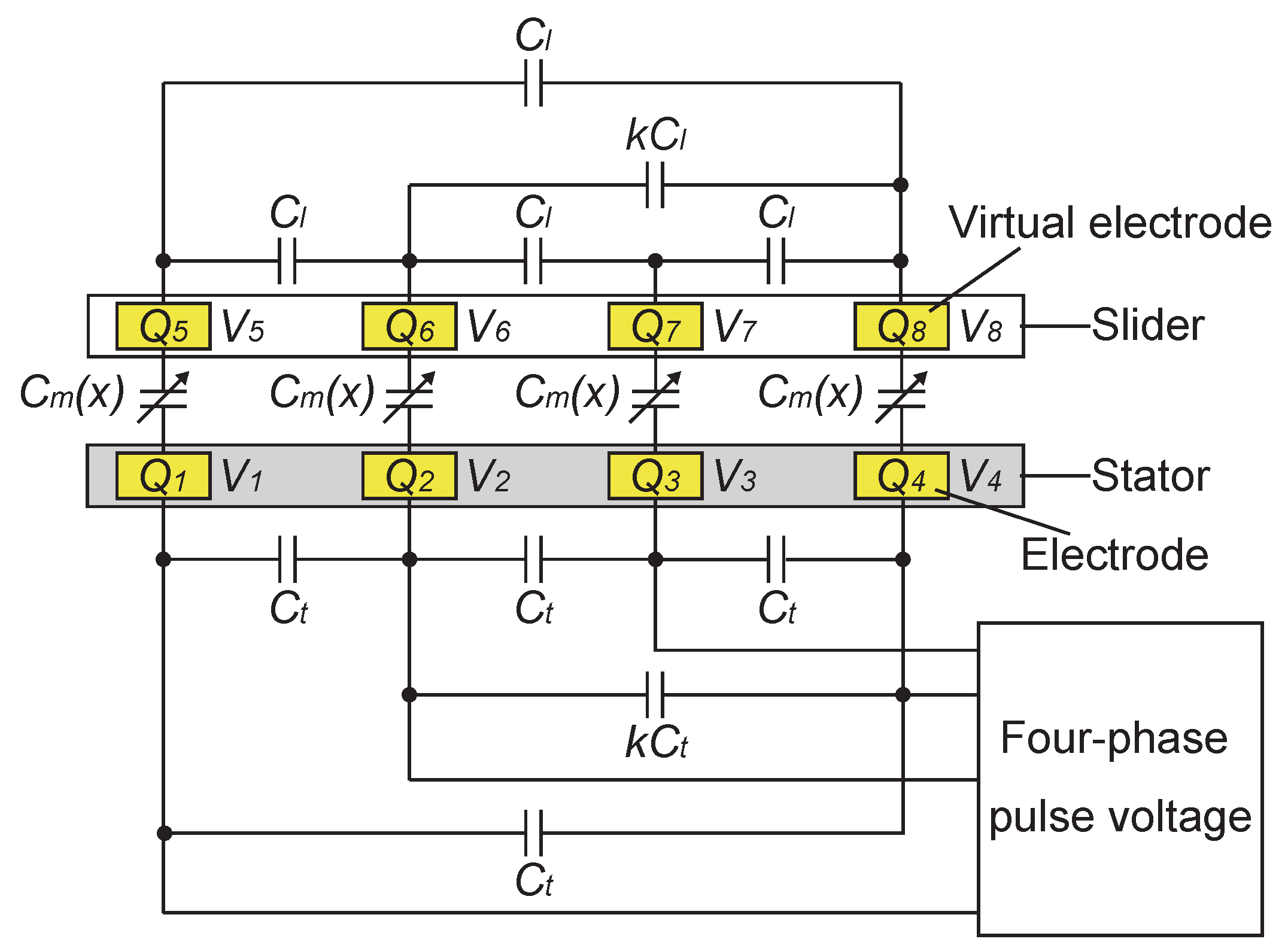
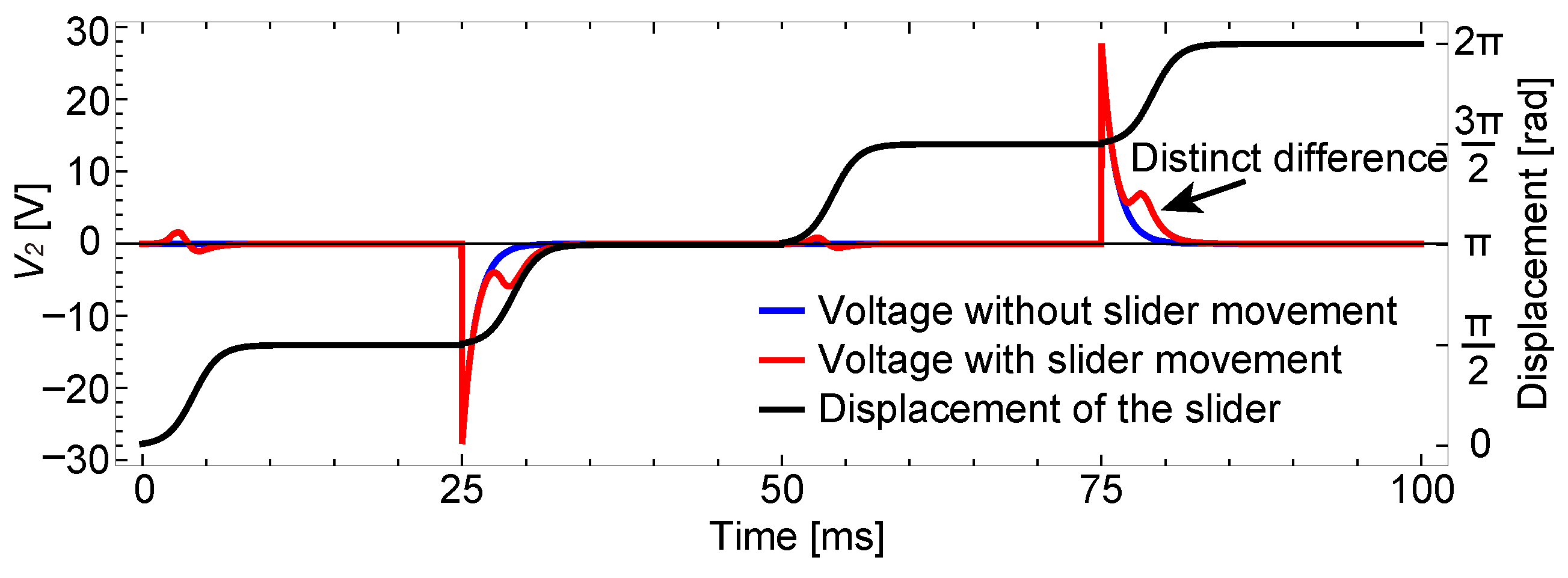
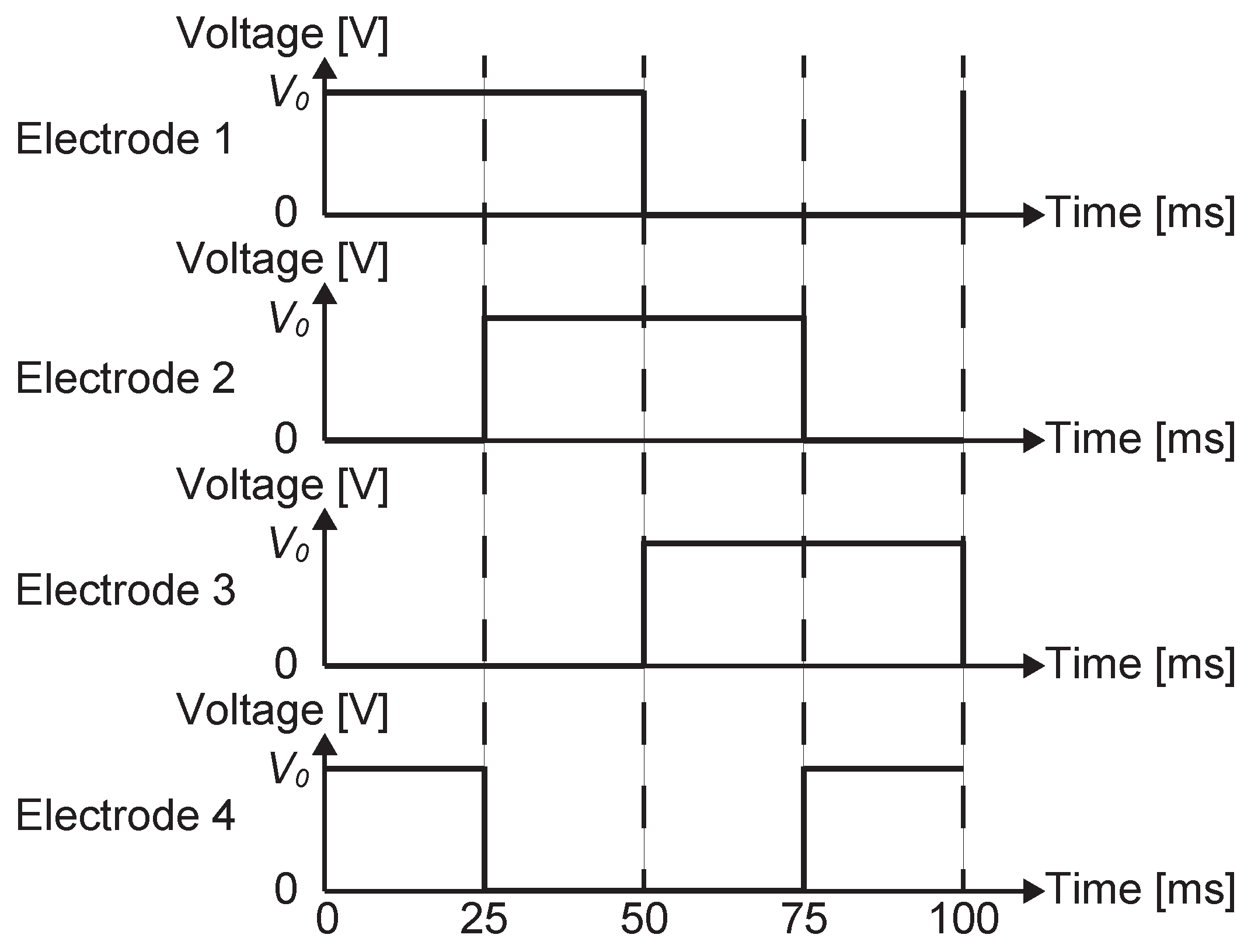


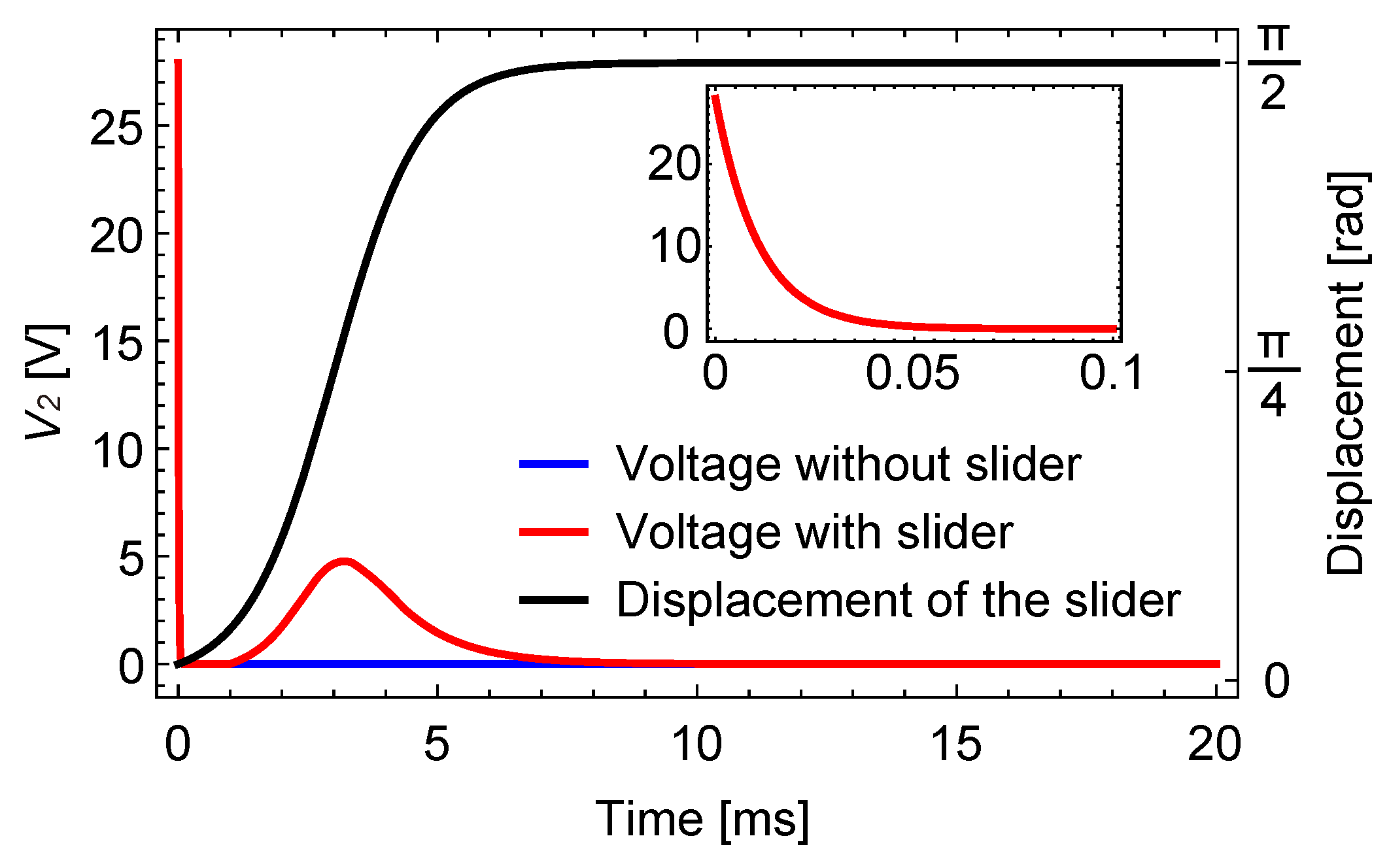




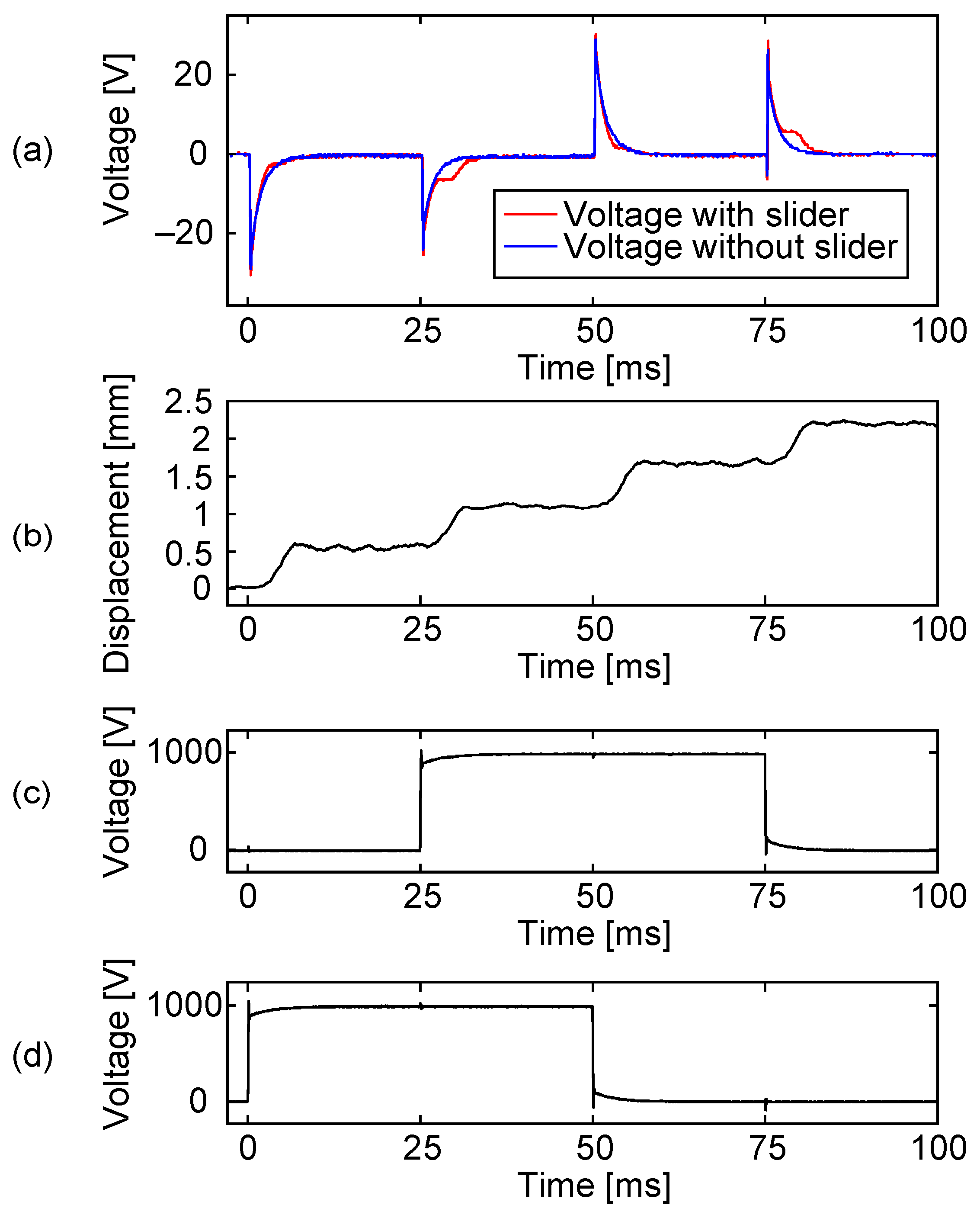

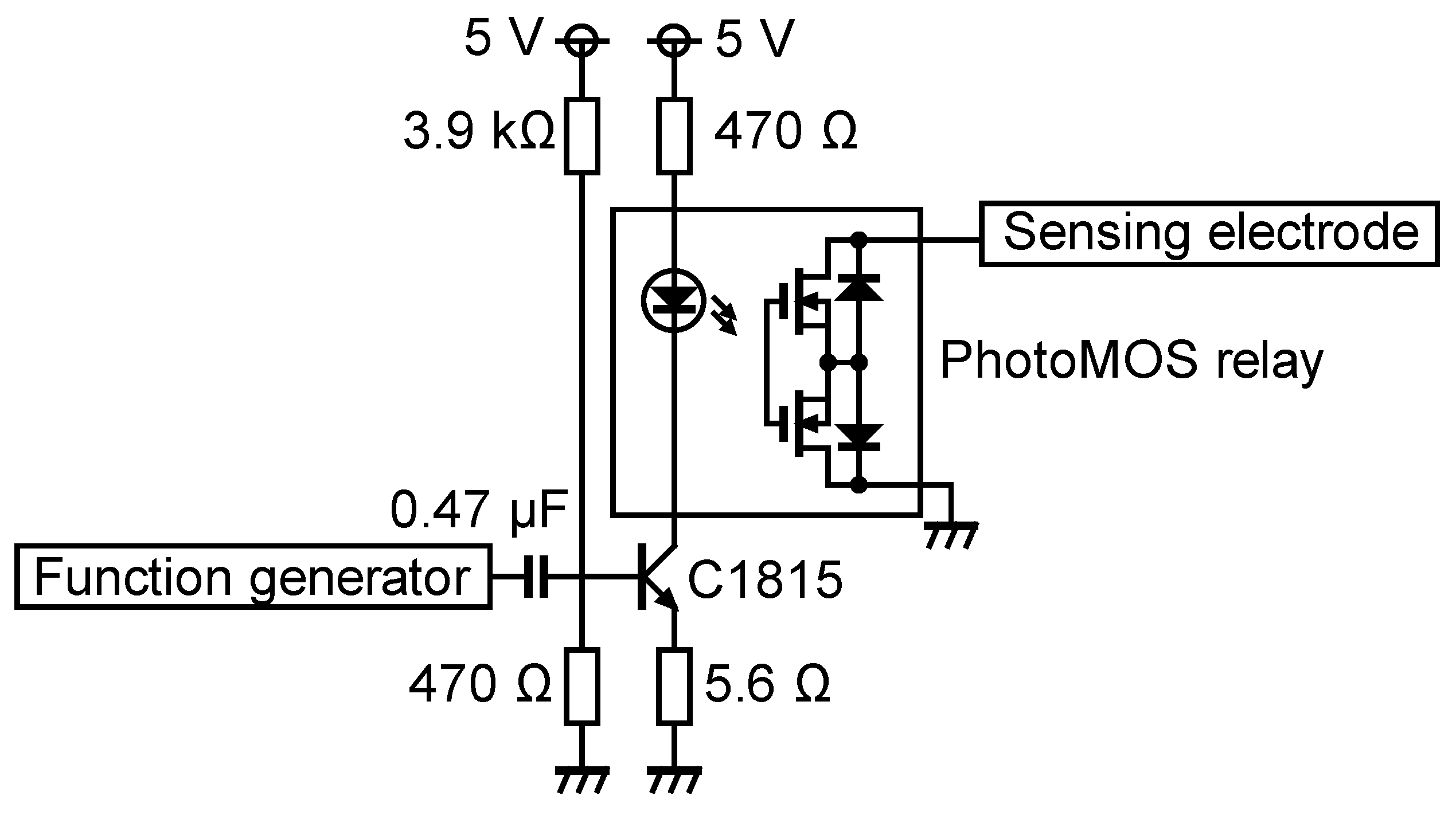
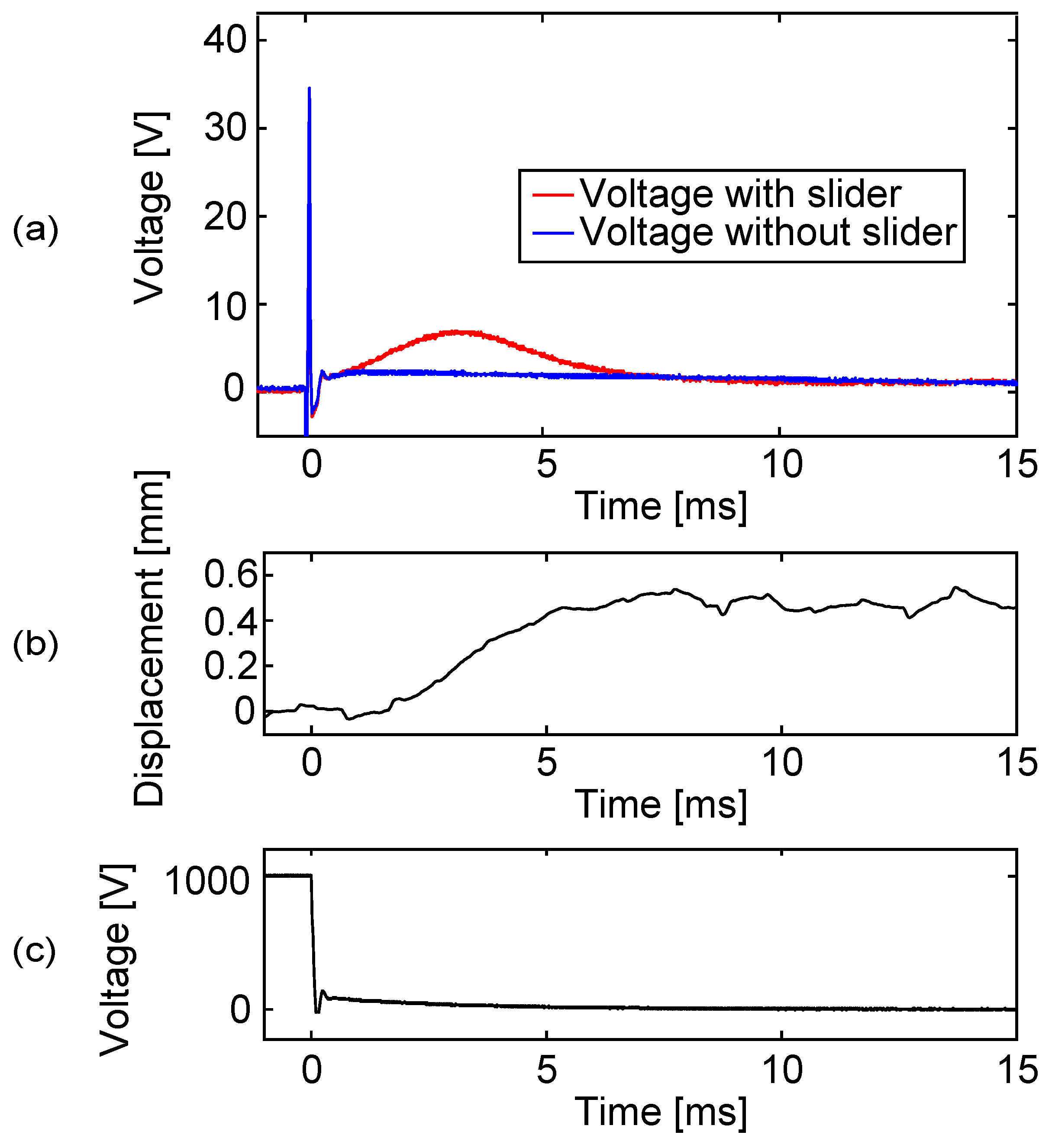
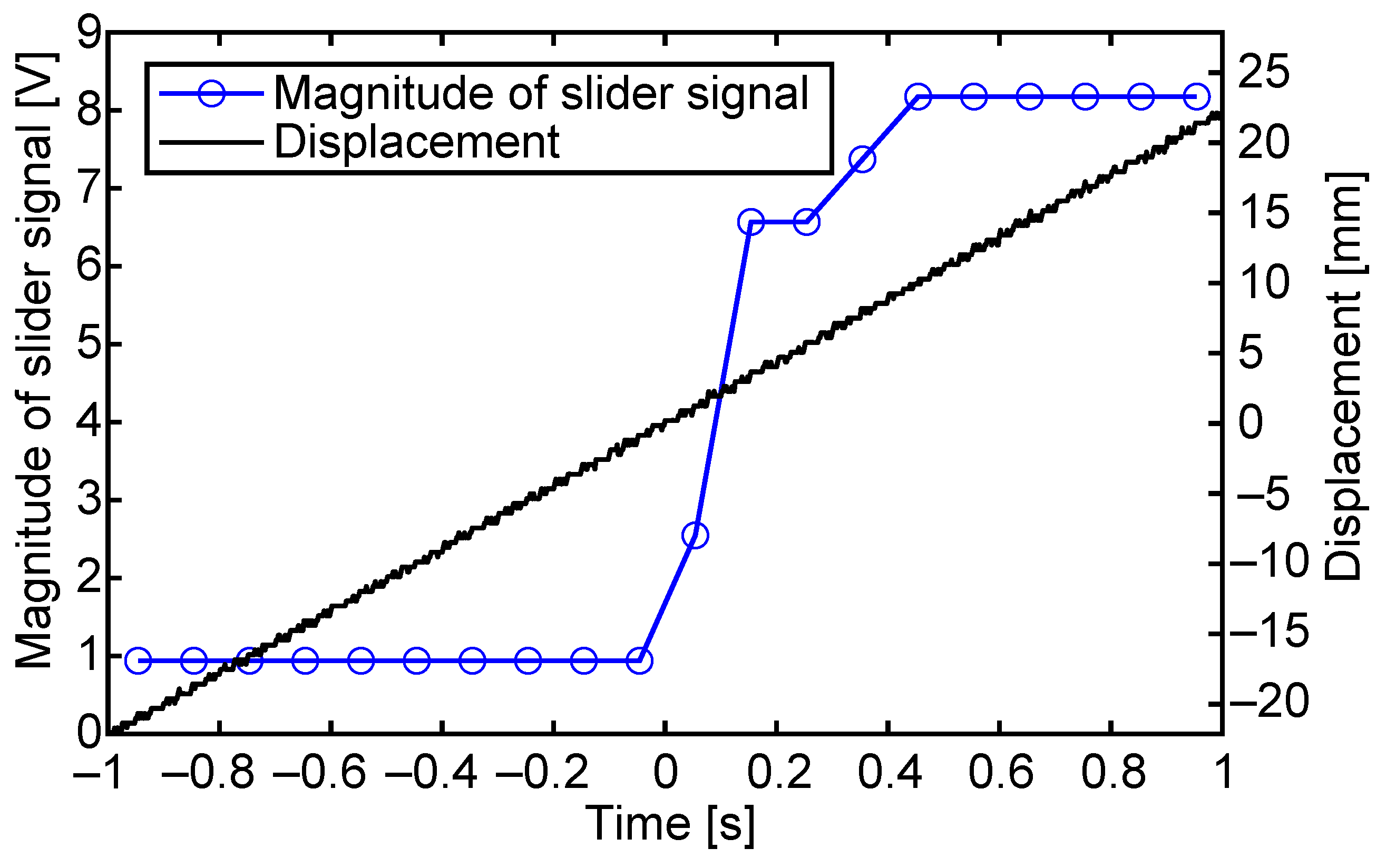

| Actuator Type | Variable Capacitance | Charge Induction | ||
|---|---|---|---|---|
| (Low R Slider) | (High R Slider) | |||
| Ref. | [43] | [47] | [44] | This work |
| Principle | (*1) | (*2) | (*3) | (*4) |
| Electrode pitch | 0.2 mm | 0.2 mm | 1 mm | 0.6 mm |
| Max error | 43 μm | ∼0.2 mm | 10–20 mm † | |
Disclaimer/Publisher’s Note: The statements, opinions and data contained in all publications are solely those of the individual author(s) and contributor(s) and not of MDPI and/or the editor(s). MDPI and/or the editor(s) disclaim responsibility for any injury to people or property resulting from any ideas, methods, instructions or products referred to in the content. |
© 2023 by the authors. Licensee MDPI, Basel, Switzerland. This article is an open access article distributed under the terms and conditions of the Creative Commons Attribution (CC BY) license (https://creativecommons.org/licenses/by/4.0/).
Share and Cite
Kojima, M.; Yoshimoto, S.; Yamamoto, A. Slider Sheet Detection in Charge-Induction Electrostatic Film Actuators. Sensors 2023, 23, 1529. https://doi.org/10.3390/s23031529
Kojima M, Yoshimoto S, Yamamoto A. Slider Sheet Detection in Charge-Induction Electrostatic Film Actuators. Sensors. 2023; 23(3):1529. https://doi.org/10.3390/s23031529
Chicago/Turabian StyleKojima, Motoki, Shunsuke Yoshimoto, and Akio Yamamoto. 2023. "Slider Sheet Detection in Charge-Induction Electrostatic Film Actuators" Sensors 23, no. 3: 1529. https://doi.org/10.3390/s23031529
APA StyleKojima, M., Yoshimoto, S., & Yamamoto, A. (2023). Slider Sheet Detection in Charge-Induction Electrostatic Film Actuators. Sensors, 23(3), 1529. https://doi.org/10.3390/s23031529






